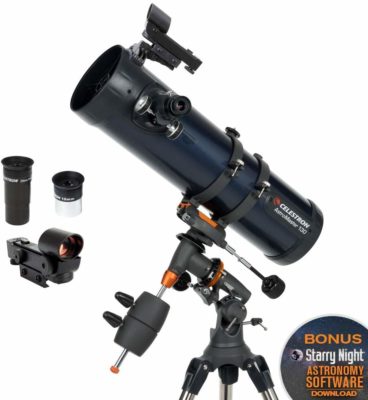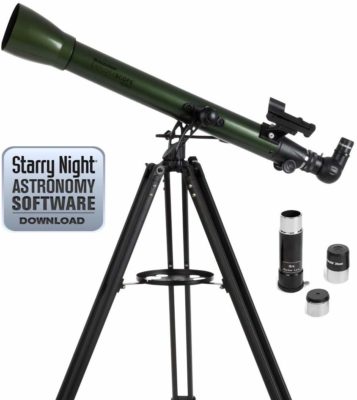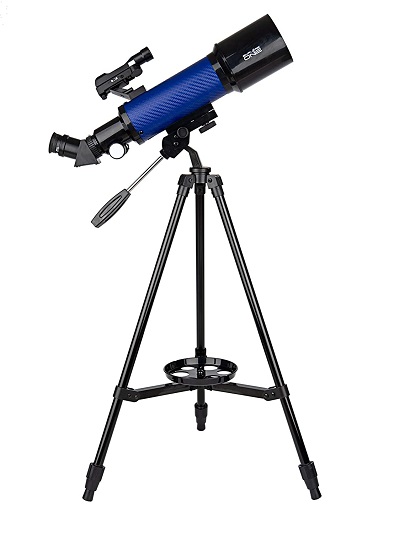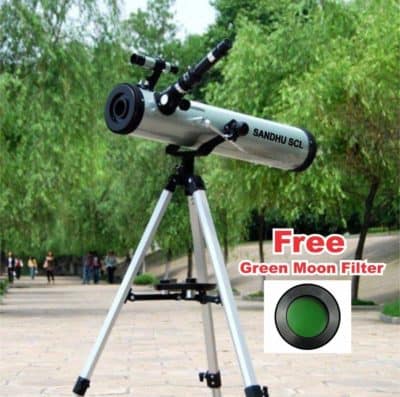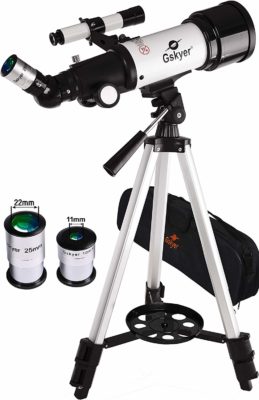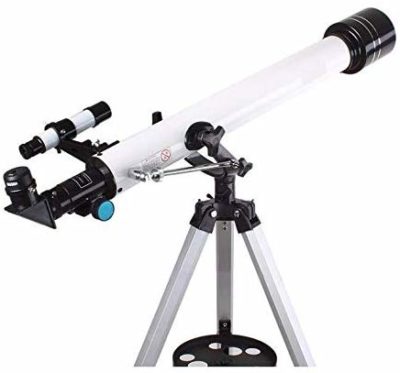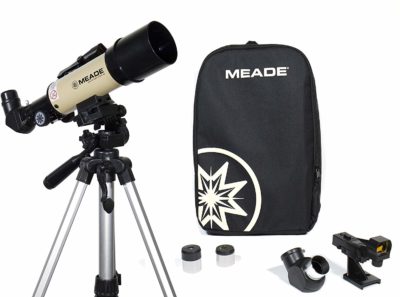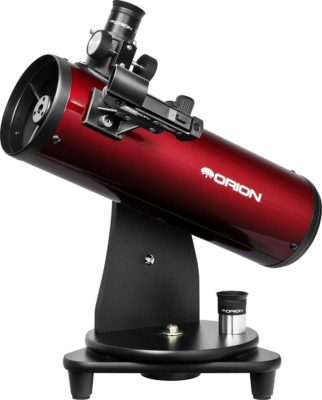8 Best Telescope for Beginners in India
The universe is such a wonderful place with unlimited works of nature to explore. At the same time, human beings are born with an adventurous spirit. And while we all can employ visual senses to dig into the different objects on earth and beyond, the ability is by far limited over long distances.
Human eyes can only focus on objects with scrutiny up to maybe a few hundreds of meters. The good news is- with the development of tech gadgets such as the telescope, taking a journey into the distance with your eyes is effortless.
Whether you find satisfaction staring into the sky or distant geographical features on earth, a telescope can uncover what’s beyond the naked eye’s field of view.
If you are new to this, don’t worry! In this article, we have covered everything you need to know about telescope shopping.
Here you will find the information regarding different types of telescope, things to consider before buying a telescope along with the list of top telescope available online and a few FAQs.
Top 8 Best Telescope for Beginners in india
| Product (Best Brands) | Best Price |
|---|---|
Best Reflector Optical Design | |
Red Dot Finder Scope | |
Moon Filter | |
Best Refractor Optical Design | |
Mid-range Pick | |
High-power Visuals | |
Table Top Design |
Types of Telescopes
Until now, there are three main types of telescopes, namely; refractor, reflector, and compound telescope.
As you might expect, each is optimized to suit different use scenarios. Again, all three designs employ slightly different optic techniques to make far-flung objects to appear bigger and closer to the eye. Don’t forget, each type has merits and limitations.
Refractor telescopes
Refractor telescopes are perhaps the most common type you are likely to come across. They are designed with a big lens at the front of the tube.
The lens passes light directly into the mirror fitted at the back and into the eyepiece. The design is particularly ideal if you want to focus on objects on earth.
Beyond that, they are suitable for beginners thanks to their largely easy to use and maintenance-free design. On the contrary, they can be bulky and less efficient when it comes to focusing on faint objects.
Reflector telescopes
Reflectors like the name suggest come with a mirror at the rear end of the main tube. It’s the mirror that draws light and sends it via another mirror into the eyepiece.
Unlike refractors, telescopes they thrive at viewing faint objects and provide high-quality images while at it. Otherwise, although they are generally lightweight and compact, they’ll demand regular maintenance.
Compound telescopes
These are hybrid models that employ a blend of lenses and mirrors. In use, they are fantastic for focusing on faint celestial objects and distant geographical features.
They are also ideal for astrophotography. Of course, given the advanced design, they tend to cost you more.
What to Consider When Buying the Right Telescope for Beginners
As a beginner, it can be tedious to pick out the right telescope for your needs. To help you select the most suitable device for your needs, we’ve put together this comprehensive guide. Now read on.
Aperture
The aperture is perhaps the most vital feature in any telescope. It refers to the diameter of the lens or mirror used on a telescope.
In principle, it determines how much light comes into the telescope, in effect determining the clarity of images. It means, to get clearer images, you need to ensure the model of choice has a bigger aperture.
Have in mind a bigger aperture means the gadget’s size will also be considerably larger. Depending on how many details you would like to see, you can work out a suitable aperture.
Focal length
The focal length implies the total distance of a telescope’s focal point to the lens/mirror. It is what determines how large an object will appear.
Ideally, you should strive to find a model with a bigger focal length. That way, you can enjoy focusing on larger-looking objects.
Of course, the focal length isn’t the ultimate determinant of the size of viewed objects. You have the alternative of playing around with different eye lens sizes for better views.
Mount/Support
In use, the telescope requires sturdy support to keep it in the desired viewing position. Therefore, you need to consider getting a complete package that includes a convenient mount.
You’ll notice telescope mounts come in varying designs and shapes, but they all boil down to two basic types- the alt-az (altitude-azimuth) and equatorial types.
The alt-az is revered, for it allows up-down and left-right scope movement. It also boasts of a quick hassle-free setup.
On the contrary, the equatorial employs a more complex mechanism and tend to be heavier, but help can track celestial object thanks to easy motorization.
All said and done; a good telescope should come with reliable support that allows seamless shifting of the viewing position and easy to set up too.
Magnification
Another feature you’ll need to pay attention to is the magnification capability. Each telescope is designed to offer varying magnification.
Usually, the magnification is determined by the eyepiece and the focal length. The good news about this is that you can always get creative by changing the eyepiece to get desired magnification.
For instance, if the focal length is less, you can get a better eyepiece depending on whether you need high or low magnification.
Control
In the market, you will find telescopes that require your intervention to operate and others that work almost on their own. You need to ask these questions.
Do you prefer manual operation? Do you want the telescope to help you find objects to focus on? Or are you better off with a combination of both manual and automatic techniques?
For hobbyists, the control shouldn’t be such a big deal. But if you are buying a gadget for astrophotography, an electronic telescope is the best option.
Type
As already highlighted, there are various types of telescopes, each coming with strengths and weaknesses. To ensure you meet your objectives, compare what each type of telescope has to offer versus your needs. Whichever has all the essential features and pointers that favour your circumstances of use- that’s it.
For instance, if you want one for astronomical viewing- a reflector telescope is the better option. Alternatively, you are more interested in viewing distant objects across the earth’s surface; refractive would do the job.
Sturdy build
Given that a telescope is mostly used outdoors, an ideal product should be well-placed to endure typical environmental pressures. The construction quality and material should, therefore, be key focus areas.
To get value for your money, the product of choice should serve you for an extended period without requiring costly or regular maintenance.
Ease of use
You don’t want to struggle setting up or tweaking the controls of the telescope to get clear views.
As such, in your quest for an ideal product, try settling for a model that offers a hassle-free user experience without compromising the functionality.
Everything from setting up to adjust the magnification, and identifying the objects to focus on should be a walk in the park.
Accessories/Extra features
Besides the basic features, accessories and add-ons can help you make the most out of any gadget.
Therefore, for a better experience and added convenience, prefer a product that includes things such as smartphone mount, extra interchangeable eyepieces, cleaning kit, filters, and more.
That way, you’ll be able to achieve better clarity and do other things, such as taking pictures without much ado.
Price
In the market, you’ll find everything from cheap to expensive and everything in between.
For the most part, the more you pay, the more you are likely to get a product with better features and performance.
But this is not always the case.
Some affordable alternatives offer convincingly reliable functionality. Of course, your budget should be a key determinant here.
The best way to navigate the price question is to strike a balance between what you can afford and the features that are important to you.
Top 8 Best Telescope for Beginners
1. Celestron AstroMaster 130 EQ Telescope – Best Reflector Optical Design
The Celestron AstroMaster 130 EQ Telescope is designed to open up distant objects in the universe.
It is equipped with high-quality features that promise unmatched performance at its class.
For instance, it comes with an impressive 130mm reflecting aperture and is capable of providing up to 364X magnification.
It does not only enable one to focus on distant objects, but it does so with great detail and precision. Then again, it comes with an advanced equatorial mount that provides adequate support and allows seamless adjustment for better views.
In all, this telescope is easy to set up and use so you can enjoy the sight of planets and galaxies trouble-free.
- Utilizes a Newtonian reflector optical type that provides an unmatched viewing experience
- Includes an advanced Equatorial mount to enable hassle-free adjustment of viewing position
- Has a massive 130mm aperture (approximately 5.11 inches) to provide a large field of view and clear images
- Features a built-in StarPointer FinderScope to help spot and keep track of objects of interest more precisely
- Ideal for deep sky observation
- Smooth and stable mount
- Easy to set up and use
- Great for day and night viewing
- Includes all the basic accessories
- Comes with the First Light Edition astronomy software
- Sturdy build
- Versatile dual-purpose gadget
- Needs a Barlow lens to exploit the full potential
2. Celestron ExploraScope 22100 60AZ Refractor Telescope – Red Dot Finder Scope
Given its features, there is no doubt that Celestron ExploraScope is crafted with the needs of beginners in mind.
Combining a fresh-looking design and utility features, it has all it takes to enable users to enjoy an exceptional viewing experience of celestial objects.
Although it uses a reliable mirror/lens, the real kicker lies in the red dot Finderscope. Spotting objects and turning them to the center of the field of view cannot get any easier.
Overall, the ExploraScope provides an out of the box user experience no matter your operation skills or experience.
- Has a fresh and good-looking design making it an ideal pick for those who value style and aesthetics
- Comes with a redesigned mount that provides support and ensures stability when in use
- Features a new altitude slow motion rod that provides for smooth and precise control and pointing
- Includes a star pointer Finderscope with an illuminated red dot that helps to view navigation and to aim at target objects
- Boasts of a versatile refractive design that works for terrestrial observation and astronomical viewing
- Comes with two eyepieces and a 3X Barlow lens for multiplying eyepiece magnification
- Perfect for discovering celestial objects
- Comes as a complete user-ready package
- Stable mount, Quick and easy setup
- Affordable and value for money
- Portable and Compact overall size
- Slow-motion control requires some practice to master
3. EXPLORE ONE Astronomy and Terrestrial Telescope
Explore One Astronomy and Terrestrial Telescope comes with great focal length and Smartphone adapter. It is easy to use and suitable for kids and adults as it is a beginner telescope.
It helps in exploring the night sky, rings of Saturn, craters of the moon, bands of Jupiter and other planetary bodies. It can also be used to get a clear and close up view of landscapes, scenery, birds and other wildlife.
- It features a 70 mm clear aperture front lens and 400 mm focal length
- It includes a Smartphone adapter for easy captures and share
- This product includes two 1.25 inch eyepieces, an adjustable pan and tilt alt-azimuth mount, 45? erecting prism diagonal and a red dot viewfinder
- It is ideal for beginners and intermediaries
- This product helps to locate and focus on objects of higher interest
- It is an easy to use achromatic refractor telescope
- It moves both vertically and horizontally
- No negative points were observed
4. SSEA Reflector Astronomical Telescope MOD 76700 – Moon Filter
The SSEA Reflector Telescope is another great pick for observing constellations, nebula, and the moon, among other celestial objects.
It comes with a strong and sturdy build to guarantee exceptional performance for years. You will appreciate that no expert skills are necessary to install and begin viewing.
Granted, the product comes with all the components and accessories required to put it to use. And if you have an eye for style, you’ll be glad the overall design and outlook serve just that.
- Features a large aperture providing a larger field of view and enhances the clarity and visibility of images
- Boasts of a robust and durable body with stylish finish guaranteeing durability in use
- Comes with a handy tripod stand to provide mounting support when in use
- Includes a green moon filter to enhance the viewing experience
- Employs high definition lenses offering varying magnification (up to 525X)over different distances and object sizes
- High-powered night vision capability to allow optimal performance in the cover of darkness
- Includes multiple ocular lens options (H20mm, H12.5mm, and SR4mm) to provide for different observation needs
- Strong and durable build
- Easy to use
- Stylish and trendy look
- Reasonably priced at its size
- Impressive clarity and visibility
- Compact and portable
- Ideal for the earth and astronomical viewing
- Lacks automatic operation
5. Gskyer AZ70400 Astronomy Telescope – Best Refractor Optical Design
Are you craving to focus far into the world with more clarity? The Gskyer Telescope rings all the bells and whistles necessary to get the job done.
As a refractor telescope, it is optimized to provide an exceptional viewing experience over works of nature spread into the distance around the universe.
The Gskyer boasts of high-quality construction made possible by the latest German Technology. Specifically, the lens has been crafted using aluminum alloy and big-caliber non-dispersive optical glass-ZF4.
Again, it is plated with a multi-layer film to ensure safe viewing. The quality is nothing but top of the line. With its two optional lenses, you can choose between low magnification (16X) and high magnification (40X).
Most of all, the set up is quick and easy, meaning both seasoned users and beginners alike can enjoy the top-level performance.
- Its tube is made of high-quality aluminum alloy for durability.
- Features flexible eyepieces place that allowing changing of the eyepieces for more clarity
- Has antireflection blue film optical coating that helps protect vision from extreme light
- Has a handy adjustable wheel which enables attainment of clear vision through simple tweaks
- Comes with a handbag made of premium canvas to help the user carry the telescope conveniently
- Comes with an adjustable aluminum tripod for mounting support
- Includes two eyepieces 25mm and 10mm for low and high magnification essentially allowing variety in viewing
- Has a 70mm (2.75 inches) aperture and a 400mm focal length to provide a better view
- Easy to set up and use
- Ideal for professionals and hobbyists
- High and low magnification
- Safe viewing experience
- Provides bright and clear images
- Lightweight and easy to carry around
- Comes as a complete ready to use the package
- High quality and durable construction
- A little pricey for beginners
6. ASkyl 525X Astronomical Telescope – Mid-range Pick
If you are looking for a beginner telescope to help you explore the planets, stars, moon, and the galaxy visually, this could be what you need.
Coming with a standard configuration that includes a 60mm aperture and 700mm focal length, it holds immense magnification and viewing potential ideal for beginners.
What’s more? It employs high-quality lenses alongside a multi-layered coated glass that enhances the optics and protects the eyes.
It means a user will enjoy an exceptional viewing experience both during the day and at night. Above all, the ASkyl Telescope is easy to set up and use, so concentrate on viewing without the slightest hesitation.
- Features a configuration that includes an optical refraction design, a 60mm aperture and 700mm focal length making ideal for beginner use
- Equipped with a multi-layer glass green coated optics ensuring better image brightness while also protecting the eyes
- Comes with an adjustable Altazimuth aluminum alloy tripod with slow motion control that offers mounting support and aids precise tracking of objects at all times
- Comes with standard three sets of eyepieces (SR4mm, H12.5mm, H20mm) with multipliers for different magnifications
- Features an HD Finder Monocular Spotting Scope to help pick out objects of interest for observation
- Includes 1.5X erect image mirror that helps optimize image clarity
- Designed and manufactured using fully coated green glass optical components as well as high transmission coatings for enhanced image clarity
- Precision tracking control
- Performs day and night
- The optical coating enables a better viewing experience.
- Delivers clear and bright images
- Guarantees eye safety
- Easy to set up and use
- Interchangeable eyepieces
- The mount can be shaky on uneven surfaces
7. Meade Instruments Adventure Scope – High-power Visuals
As the name suggests, the Meade Instruments 60mm Scope is designed for unmatched visual adventure.
Whether you are seeking objects far away during the day or at night, it has all the necessary features to allow on the go observation.
The construction is considerably lightweight and can easily be carried from place to place as you want. And to help with portability, the manufacturer includes a rugged backpack that loads everything for hassle-free carrying.
- Employs a high-quality achromatic refractor optical design
- Has a 60mm aperture and focal length of 400mm which allow a wide field of view
- Comes with a lightweight aluminum tripod for mounting support
- Includes a rugged backpack that fits the main gadget and all the accessories
- A high-powered visual capability that allows viewing both during the day and at night
- Equipped with red dot finder scope that helps users locate objects easily
- Includes two interchangeable eyepieces to allow varying viewing options depending on needs
- Has modest dimensions of about 29 by 25 by 49 inches and weighs 2.8 pounds
- Perfect for day and night use
- Portable and ideal for on the go use
- Comes with ready to use with all the basic accessories
- Works with different eyepieces
- Sturdy construction
- No negative points were observed.
8. Orion 10012 SkyScanner Reflector Telescope – Table Top Design
A product that is functional and aesthetically pleasing, too, the Orion 10012 Skyscanner is fantastic for astronomical viewing.
The optics are quite impressive, allowing the user to enjoy a great view of planets, moon, and the stars.
While the manufacturer cut down on the mounting support, the tabletop design is convenient for typical beginner viewing needs.
Besides, the minimalist design makes it great for on the go use. In all, the Orion 10012 Skyscanner is a good bet for detailed observation and exploration of celestial objects.
- Equipped with 100 mm parabolic primary mirror aperture to allow viewing in great detail
- Has a minimal tabletop design that is small enough for easy storage and portability and powerful enough to find and observe objects and night
- Employs reflector telescope optical design optimized for wide-angle, low-power viewing of the Milky Way and other objects lying deep in the sky
- Comes with two 1.25 inch eyepieces 20mm and 10mm for optional magnification
- Includes an EZ Finder II aiming device for easy spotting and tracking of objects of interest
- Have dimensions measuring about 24.1 by 24.1 by 35.6 cm and weighs about 2.81 kg
- Perfect for starters
- Convenient tabletop design
- Provides clear and detailed views
- Optional low and high power magnification
- A great pick for grab and go used
- Impressive image quality
- The tabletop design could be limiting especially for outdoor use
Frequently Asked Questions
1. Which telescope type should I get?
All three popular types are designed to offer optimal performance under different circumstances.
For beginners going for a refractor telescope is usually the best option. That’s because refractors are generally easy to use and require minimal maintenance.
They are also great for viewing objects on earth. As a rule, go for what suits your needs. For instance, if you are into viewing deep-sky objects, a reflector telescope is more ideal. The same way compound type is suitable for those who are into astrophotography.
2. What should I look for in a beginner telescope?
As a beginner, you need a gadget that can open your eyes to the distant objects with clarity and precision. To achieve that, the two most important features you should give priority are the aperture size and lens.
These determine how much light gets in and the magnification potential, respectively. Otherwise, you should also go for a telescope that is easy to use with reliable mounting support.
3. What are the ideal size and weight of a telescope?
Again, this goes back to your needs. You need to ask yourself how much weight you are willing and able to carry around. Of course, the weight and size only matter if you are buying the device for on the go use.
If you only use it at home or in one place, it shouldn’t matter much because most telescopes in the market aren’t as bulky and heavy.
4. How much should I pay for a beginner telescope?
Today, there are so many manufacturers offering all manners of a telescope at different prices. The price scale is anything from cheap to expensive.
Because of the variety, one shouldn’t worry about the price. Instead, focus on the features that you want and strike a balance depending on your budget.
5. What is the best telescope in the market?
Like any other product, there are different brands and models producing quality telescopes. Fact is- each product is optimized to work best in specific circumstances.
What works for celestial viewing may not perform with similar efficiency in a different situation. So, the only way to pick out the winner is picking out what is likely to serve your needs better.
Conclusion
Choosing the right telescope is all about knowing the basics. You will come across tons of advice flying from every direction. Don’t fall for any hype. It’s all about you and your needs. So, your preferences should dictate what you pick eventually.





